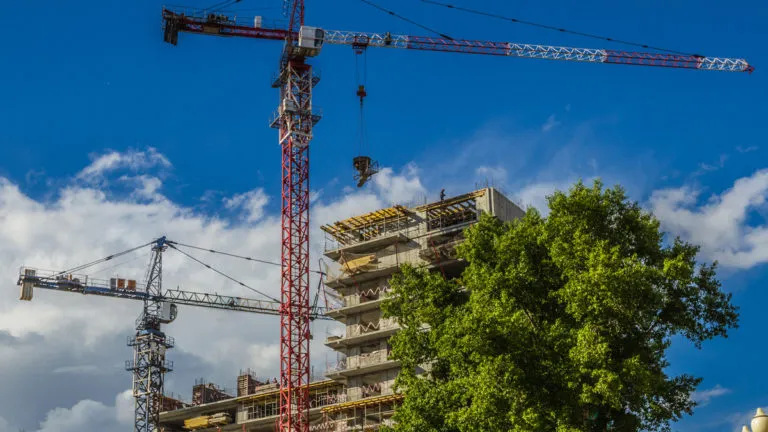Conservative Party Conference: Where next for planning?
Published: by Cecil Sagoe

Since Robert Jenrick was appointed Secretary of State for Housing in July, he’s made no secret of his ambition to ‘liberalise and improve the planning system.’ Jenrick’s speech at the Conservative Party Conference on Monday offered a mixed bag of proposals.
In a welcome move, the government has published a new national design guide which sets out the characteristics of well-designed places. But government is also proposing to move ahead with planning deregulation that will make enforcing these new standards impossible, jeopardise the delivery of high-quality social-rent housing and undermine local democracy.
Expansion of permitted development rights
In the run-up to the Conservative Party Conference, we were concerned that given his statements on planning, Jenrick might announce an expansion of permitted development rights (PDR). As we have explained time and again, including in our response to the government’s consultation on this last year, expanding the reach of PDR will not solve our housing crisis.
Under this system, some classes of development do not need planning permission. New housing is created with only the lightest touch regulation. That means there is no opportunity to get much-needed social-rent housing through section 106 agreements, and developers can get out of their usual obligations to contribute to local transport and other infrastructure. It also means that quality, design and size standards do not apply, and undermines local democracy, bypassing the views of local people.
The inevitable result is families living in cramped, miserable conditions, often in housing created from former office blocks, agricultural buildings, warehouses and launderettes. We need new homes, but this is not the way to do it.
So we were disappointed to hear that government does plan to expand the permitted development system, allowing developers to create two storeys of new homes on top of existing blocks of flats without having to adhere to standards or provide the social housing we desperately need.
Changing plans for commercial demolitions and rebuild
But there are signs that the government may be starting to listen to concerns about the kind of housing created in this way.
Last year, government consulted on expanding the permitted development system to cover demolitions of commercial buildings. Under these proposals, commercial buildings could be knocked down and replaced with residential ones with barely any scrutiny. Because of the huge numbers of developments potentially included in this, it was a particularly worrying proposal that we, and many others in the sector, strongly opposed.
It seems like these concerns have started to cut through to government. Jenrick has announced he will seek further views on the future of commercial demolitions before making a final decision, and news reports suggest government is exploring alternatives to permitted development, including some version of the ‘permission in principle’ planning consent route introduced from 2017.
‘Permission in principle’ is made up of two stages:
- In the first stage, the local authority establishes whether a site is suitable for housing development in principle, and establishes the minimum and maximum number of homes that could be delivered on the site.
- Then, in the technical details consent stage, the local authority makes sure the scheme complies with local policies – including any policies on social and affordable housing, space standards and infrastructure contributions.
The ‘permission in principle’ route is certainly preferable to permitted development, but there are still two issues to be wary of within this proposal.
Firstly, we are concerned about how permission in principle may interact with the new viability rules government introduced last year. How will developers ensure they pay for land at a price that enables social and affordable housing to be built if they don’t even have certainty about basic decisions, like the overall number of homes they will build until the technical details consent stage?
Secondly, the ‘permission in principle’ stage still risks undermining local democracy. Communities may have no say over whether a site containing an old commercial building is suitable for demolition and redevelopment as housing.
The way forward
It’s far from perfect, but make no mistake, ‘permission in principle’ is a far better way of building new homes than permitted development. We welcome government’s partial change of approach on this issue.
We are grateful to the many organisations who worked with us to highlight the risks of deregulating planning, including the Local Government Association, the Town and Country Planning Association, the Chartered Institute for Housing, Levitt Bernstein, the Royal Institute of British Architects, the National Housing Federation, CPRE the Countryside Charity, the G15 group of London housing associations and Crisis, as well as countless organisations and individuals from all levels of government, academia, the media, planning and conservation.
But government’s new proposal still poses risks for future social housing supply and for the role of communities in shaping local development. We need more information on exactly how government wants a new ‘permission in principle’ to work, and on how it intends to manage the risks it will create. So far, there has been no government review of the existing ‘permission in principle’ system to inform further changes.
Finally, government must bring an end to use of permitted developments for the delivery of new housing. Only then can planning deliver high-quality social rent homes as part of well-designed communities.